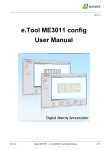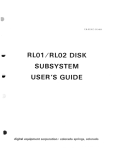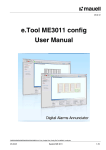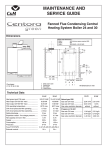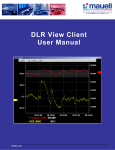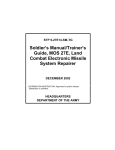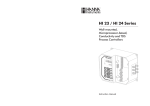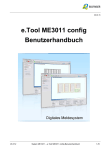Download Short Description Compact Signal Processing Systems ME 3011D
Transcript
ME 3011D / Alarm Indication / Quick Reference Guide Tables of Contents Application Features Important Safety Information! Note to this Guide Further Information Device Variants General Functions Annunciator Sequences - ISA 18.1 Plan of Terminal Connections Collective annunciation ME 3011DR Flashing synchronization of modules ISA 18.1 in Detail Technical Data International Standards Connection Technology Control and Monitoring Elements Possible variants Dimension Drawing The e.Tool ME3011 config Software Labeling of the Messages Colors of the Backlight Panel Mounting Spacing of the modules Spare Parts Connecting the Expansions Modules Page 1 1 2 2 2 2 3 3 4 8 8 9 10 10 10 11 12 13 13 14 14 14 14 14 15 Application The ME 3011D Digital Alarm Annunciator module is for registering signals, alarms, states and events from electrical systems. The gathered information can be provided locally via LED's and horn. These information's can also be provided as a group alarm or distributed via a network. 2014-08-15 Features - High degree of modularity, 4 up to 58 alarms can be configured - 3 different housing options - Basis and expansion modules available - Front panel with keypad, LED-Backlight and sound - easy to replace alarm-text on printable transparency stripes - Configuration via PC software - RS 485 Modbus RTU interface for communication with up to 15 modules - RS 232 Interface X5 for configuration - Flashing synchronization input/output - GPS synchronization input - DC and AC power supply possible - Wide range power supplies from 24 V DC up to 230 V AC - Monitoring of power supply (RLFL) for AC/DC and display via light and sound - 3 programmable relay outputs for collective annunciation (group alarm) - Plugs with spring-cage connector - isolated power supplies and signals The following options are possible: - RS 232 Interface X1 for different protocols such as IEC 60870-5-101 - Ethernet X2 interface for different protocols such as IEC 60870-5-104 - Event register for up to 1000 events - 110 up to 230 V AC/DC redundancy is possible - 9 relay outputs configurable for group alarms - Repeater relays for each alarm point - Switch-ON and OFF delay ME 3011 1-16 ME 3011D / Alarm Indication / Quick Reference Guide Important Safety Information! The device description must be read and understood prior to any installation or operation. Installation, wiring, commissioning and maintenance of the Digital Alarm Annunciator module should only be carried by qualified personnel, authorized by the plant owner and under strict compliance with the relevant standards and safety regulations. Any installation works should only be carried with the system disconnected from the mains supply. Please don't hesitate to contact us if you have questions or need any further information. The product described in this brochure is intended for industrial use and meets the requirements laid down by the EU directive 2004/108/EC. 2014 Bilfinger Mauell GmbH ME 3011D, Digital Alarm Annunciator, and e.Tool ME 3011 are names of Bilfinger Mauell GmbH products. Other trade names and product names are labels or registered brands of their owner. Each device variant has different options. Further Information ME 3011D ME 3011D+ ME 3011DR Beside this Quick Reference Guide, there is a more extensive Instruction Manual and a Software Manual for the e.Tool ME3011 configuration (available from our webspace www.mauell.bilfinger.com). X X X ME 3011D Information and data contained in this documentation may be changed without prior notice. The company names, other names and data used in examples are fictitious. This documentation or parts hereof may not be used for duplication or translation regardless of the purpose or the method, whether electronically or mechanically, without express prior writtenpermission of Bilfinger Mauell GmbH. 2-16 X X Interface card This guide describes the system ME 3011D with different device variants. Depending on the wide range of hardwareconfiguration, there is a nearly endless amount of different systems. This document only describes a few of the possibilities. Group alarm 7-15 Device Variants Signal delay Note to this Guide Current version, which will be replaced, by the variants ME 3011D+ and ME 3011DR. ME 3011D+ New variant. In addition to the possibilities of the ME 3011D, individual signal delays for the single messages are available. ME 3011DR New variant. In addition to the possibilities of the ME 3011D+, nine additional group alarm relays are available. The optional interface card is not available, because the additional relay card uses the same slot. ME 3011 2014-08-15 ME 3011D / Alarm Indication / Quick Reference Guide General Functions Sound Signal The Digital Alarm Annunciator has a horn/buzzer which can be configured to generate different sounds. Potential-free connectors are available on the rear panel for connecting an external horn. Group Alarm The group alarm function (annunciation collective) is used to combine inputs for a purposeful monitoring. A certain group alarm can have its own light indication and sound signaling. The Digital Alarm Annunciator comes standard with three relays, which can be configured to be activated if an alarm occurs in one of the three alarm groups. Via an optional annunciator module, 9 additional group alarms can be outputted. Sleep Mode - SLM The SLeep Mode is used to deactivate internal light and/or sound signaling. When active, the green RUN LED is flashing, indicating the sleep mode. The SLM can be disabled with every button. Switch-ON and OFF delay For the system variants D+ and DR, a signal delay time can be configured for each signal. Input Temporization Every input has a signal delay filter, which enables a tripping time hysteresis from 5 ms up to 600 ms in 2.5 ms steps. LED Signaling Light signaling has two flashing frequencies Normal flashing: circa 1.2 Hz Slow flashing: circa 0.4 Hz External synchronization is optionally possible. Protocol interfaces By using the optional interface module, the alarm system can use communication protocols via IEC 60870-5-101 (serial) and IEC 60870-5-104 (Ethernet). The protocol converter of the interface module works independently from the Digital Alarm Annunciator. It is separately configured via the Ethernet interface by using a web browser. Annunciator Sequences - ISA 18.1 The Instrumentation, Systems, and Automation Society (ISA) is a global, non-profit organization for setting the standards for automation. The purpose of the ISA 18.1 standard is to establish uniform annunciator terminology, sequence designations, and sequence presentation and to assist in the preparation of annunciator specifications and documentation. This Standard is intended to improve communications among those that specify, distribute, manufacture, or use annunciators. The Digital Alarm Annunciator can be configured for 16 signaling sequences. The most important are the following 7: ISA-RP 18.1/(ISA-S18.1) see page 9-16 ISA 1/(A), ISA 1A/(A-5), ISA 1B/(A-4), ISA 2A/(R-8), ISA 2C/(M) default ISA 4A/(F1A), ISA 4AR/(F1M) etc. Other sequences can be implemented on request. Keyboard OFF Allows turning off the Digital Alarm Annunciator keypad by an external key-switch. Only remote push-buttons are still enabled. 2014-08-15 ME 3011 3-16 ME 3011D / Alarm Indication / Quick Reference Guide Plan of Terminal Connections Clamp X1 X2 X3 Pin Title 1-9 D-Sub male RJ45 female 1 Sync 2 RT– 3 RT+ X4 1 2 3 4 5 6 7 X5 X6 X7 1-12 13 1-12 13 M SLM HA LA RE FT/LT KB/O RJ10 I1-I12 M R1-R12 L+ X8 X8 option single X8 option redund. 1 2 3 4 5 L1+ L2+ M +24V DC –24V DC 1 2 3 4 5 L1+ L1– NC +24V DC –24V DC 1 2 3 4 5 L1+ L1– L2+ L2– –24V DC 6 7 8 9 10 11 12 13 14 RL4a RL4b RL5a RL5b RL6a RL6b RLFL2+ RLFL1+ L+ X9 1 2 3 4 5 6 7 Meaning RS 232 Interface, for example, IEC 60870-5-101 protocols Ethernet interface, for example, IEC 60870-5-104 protocols GPS or Flashing Synchronization Modbus Interface RS 485 Inputs for remote Pushbuttons common root is (+24 V DC) Sleep Mode Horn Acknowledge Lamp Acknowledge Lamp Reset Function Test / Lamp Test Keypad OFF (Key switch) Serial interface RS 232 (cable CS-02) for Config-PC Alarm Inputs 1-12 common root (GND) Repeater Outputs 1-12 common root (+) Power Supply Inputs +24 V up to +60 V DC First supply voltage Second supply voltage GND 24 V Power supply output - auxiliary field supply 24 V root (GND) Power supply Inputs single 110 V up to 230 V Supply voltage (AC/DC) L1 Ground for L1 not contacted 24 V Power supply output - auxiliary field supply 24 V root (GND) Power supply Inputs redundant 110 V up to 230 V First supply voltage (AC/DC) L1 Ground for L1 Second supply voltage (DC) L2 Ground for L2 –24V root (GND) Programmable relay outputs (Annunciation collective, Horn) Relays 1 Relays 2 Relays 3 Relays output for voltage monitoring L2 Relays output for voltage monitoring L1 common ground for RLFL Outputs – Flatcable jacks to the expansionmodules Alarm 17-22 11-16 Alarm 23-28 17-22 Alarm 29-34 Alarm 35-40 Alarm 41-46 Alarm 47-52 Alarm 53-58 optional 4-16 ME 3011 2014-08-15 ME 3011D / Alarm Indication / Quick Reference Guide Plan of Terminal Connections Part 2 Clamp X10 X11 X12 X13 X14 X15 X16 X17 Pin Title 1-12 13 1-12 13 1-12 13 1-12 13 1-12 13 1-12 13 1-10 13 1-10 13 I13-I24 M R13-R24 L+ I25-I36 M R25-R36 L+ I37-I48 M R37-R48 L+ I49-I58 M R49-R58 L+ 1 2 2 4 5 6 7 8 9 10 11 12 13 14 15 16 17 18 19 1 2 1+2 1+2 RL7a RL7b RL8a RL8b RL9a RL9b RL10a RL10b RL11a RL11b RL12a RL12b RL13a RL13b RL14a RL14b RL15a RL15b L+ Terminator Terminator PRG PIC PE X21 B1 B2 Meaning Alarm Inputs 13-24 common root (GND) Repeater Outputs 13-24 common root (+) Alarm Inputs 25-36 common root (GND) Repeater Outputs 25-36 common root (+) Alarm Inputs 37-48 common root (GND) Repeater Outputs 37-48 common root (+) Alarm Inputs 49-58 common root (GND) Repeater Outputs 49-58 common root (+) Programmable relay outputs (Annunciation collective, Horn) Relays 7 Relays 8 Relays 9 Relays 10 Relays 11 Relays 12 Relays 13 Relays 14 Relays 15 common ground for RL15 Terminating resistor for Modbus Terminating resistor for Modbus Firmware Upload Protective Earth. Have to be connected with low-resistance! optional 2014-08-15 ME 3011 5-16 ME 3011D / Alarm Indication / Quick Reference Guide Wiring for the Alarm Annunciator 24-60 V Supply (Standard) Some plugs (base housing) are optional. For example, the repeater outputs can be omitted. 6-16 ME 3011 2014-08-15 ME 3011D / Alarm Indication / Quick Reference Guide Power Supply 110-230 V AC/DC Redundant Single Interface Module The interface module is optional. If the collective annunciations module is used, no interface module can be used, because the group alarm module uses the same slot. The redundant DC power supply is optional. But this eliminates the +24 V output (X8.4-5) of the auxiliary voltage. 2014-08-15 The configuration of the interface module is described in the user manual Protocol Converter IEC 60870-5-104 (-101) / ME 3011 (1A050101.pdf). ME 3011 7-16 ME 3011D / Alarm Indication / Quick Reference Guide Collective annunciation ME 3011DR Flashing synchronization of modules The 9 additional group alarms (RL7 to RL15) are available on X21. When using the ME 3011DR, no interface module can be used, because the group alarm module uses the same slot. For devices with this additional group alarms, the protective earth connection is on the right hand side of the module back side. 8-16 ME 3011 2014-08-15 ME 3011D / Alarm Indication / Quick Reference Guide ISA 18.1 in Detail Alarm Sequences Sequence primary Signal (1st Event) Legend Horn Off Horn On LED Off LED On – No Flashing LED Normal Flashing LED Slow Flashing 2014-08-15 ME 3011 9-16 ME 3011D / Alarm Indication / Quick Reference Guide Technical Data International Standards Power Supply standard X8.1-3: 24-60 V DC ±20 % optional X8.1-2: 110-230V AC/DC –20/+10% * X8.3-4: 110-220 V DC –20/+10 % * Auxiliary field output X8.4-5: 24 V DC / 75 mA only on standard power supply monitoring RLFL: 24 V 110 V (only at redundancy) Inputs Alarm: 4 up to 58 DC ±20 %: 24, 48, 60 V DC –20/+10 %: 110, 220 V Current: typically 4 mA Filter: 5 ms up to 600 ms Remote-Inputs: 6 x 24 V DC (Push-Buttons) Functions: SLM, HA, LA, RE, FT/LT, KB/O Sync. Flash/GPS: 24 V DC Outputs Horn/Buzzer: 90 dB / 10 cm, 4 kHz Sync. Flash: 24 V DC (Flash Sync.) RLFL1-2: 2 Relays contacts for power supply monitoring RL3-5, 7-15*: 3 + 9* Relay contacts programmable for, external horn, supply, alarm groups Capacity of RLFL1-2 and RL3-5, 7-15 Relay contacts: 30V DC-1.0A ohmic load 120V DC-0.1A / 250V AC-0.5A Repeater R1-n*: 1 Relay contact per alarm 30V DC-1.0A ohmic load 240V DC-0.1A / 250V AC-2A Interfaces RS 232 RJ10 - female Baud rate: 9600, n, 8, 1 Protocol: Modbus RTU or Modbus RTU + TS (Remote Terminal Unit) RS 485 Phoenix connector Baud rate: 100 up to 19200 baud Parity: even, odd or none Stop bits: 1 or 2 Protocol: Modbus RTU RS 232* 9-pol D-Sub Male Baud rate: max. 115 kBaud Protocol: on request Ethernet* RJ45 Baud rate: 10/100 Base-Tx Protocol: on request Ambient Conditions Storage temperature: –20 to +80 °C Operating temperature 0 to +55 °C Humidity class: 0 to 95 % without moisture condensation Protection class Front: IP 41 Housing: IP 30 Electromagnetic Compatibility (EMC) Electromagnetic Immunity DIN EN 61000-4-2 ESD; contact discharge 4 kV . air discharge 8 kV 61000-4-3 EM-HF-field; 10 V/m 61000-4-4 Burst Signal-Inputs: 1 kV Power Supply: 2 kV 61000-4-5 Surge Signal-Inputs sym.: 1 kV Power Supply sym.: 1 kV Power Supply asym.: 2 kV 61000-4-6 HF inflow: 10 V 61000-4-8 50 Hz magnetic fields continuous field: 30 A/m Electromagnetic Emission DIN EN 55011 Radio noise emission Group 1, Class A Electric Safety DIN EN 50178 Quality requirements IEC 60255-5 Isolation strength Signal-Inputs: Class 3 Power Supply: Class 2 Connection Technology Phoenix®-plugs: COMBICON FKC 2,5 Maximum conductor cross section: one-strand 0.20 to 2.5 mm² fine-strand 0.20 to 2.5 mm² fine-strand 0.25 to 2.5 mm² with DIN 46 228 end splice ® COMBICON MC 1,5 ST Phoenix -plug: (for X21, X3 Modbus & Sync.) Event Register* Count of events: Resolution: 1000; including time stamp 1 ms with 2.5 ms samples * is optional 10-16 ME 3011 2014-08-15 ME 3011D / Alarm Indication / Quick Reference Guide Control and Monitoring Elements Digital Alarm Annunciator with 4 Alarms Rear View Push-Buttons LED Indication / Push-button LED RN green system is operative Flashing indicates that the system is operating in sleep mode (SLM) LED FA red Faulty Annunciator Flashes different from the alarm sequence. Detected faults are: Watch dog and Communication between Master and Slave CPU's LED L1 yellow AC/DC Fault LED L2 yellow AC/DC Fault LED Meld.1 - n user spec. Alarm is on Back side (optional for -101/-104) LED RN green normal operation LED FA red Fault Alarm LED RT yellow normal operation LED Rx yellow Receive Data LED Tx yellow Transmit Data LED Li green Link established Sound Signal 2014-08-15 Push-button - Back side (optional) S RES Reset-Push-button -101/-104 ME 3011 11-16 ME 3011D / Alarm Indication / Quick Reference Guide Possible variants The smallest Basis module provides 4 Alarms. But there are also Basis modules with 10 and 16 alarms available. Expandable Basis modules can be extended by Expansion modules, providing up to 58 alarms. Basis modules Expansion modules Basis module with 4 alarms not expandable Expansion module with 6 alarms Basis module with 10 alarms expandable with 12 alarms Expansion module with 12 alarms Backside - Basis module with 10 alarms Backside - Expansion module with 12 alarms Basis module with 16 alarms expandable with 42 alarms Expansion module with 18 alarms Backside - Basis module with 16 alarms Backside - Expansion module with 18 alarms 12-16 ME 3011 2014-08-15 ME 3011D / Alarm Indication / Quick Reference Guide Dimension Drawing The e.Tool ME3011 config Software Front View The e.Tool ME3011 config is for the Digital Alarm Annunciator-configuration via a serial interface. The Digital Alarm Annunciator provides the configuration via a RS 232 cable (CS-02) by using the e.Tool ME3011 config program. It is a one on one connection (1:1) between one Windows-PC and a Digital Alarm Annunciator. The latest e.Tool ME3011 config software can be downloaded from our website http://www.mauell.bilfinger.com Front view from a Digital Alarm Annunciator with 4 alarms Side View Side view from a Digital Alarm Annunciator 2014-08-15 ME 3011 13-16 ME 3011D / Alarm Indication / Quick Reference Guide Labeling of the Messages Panel Mounting The messages are labeled with transparencies. The Digital Alarm Annunciator is mounted with spannstücke in the cut-out of the front-panel. Cut-out size for panel mounting (WxH): 4 / 6 Alarms 91 x 91 mm 10 / 12 Alarms 187 x 91 mm 16 / 18 Alarms 283 x 91 mm The installation depth is more than 130 mm. The transparency should not be thicker than 1/10 mm. For example: AVERY Zweckform Inkjet Transparency 2502 You will find a corresponding PDF form under 3011 on our website http://www.bilfinger.mauell.com. Spacing of the modules During the assembly of the basis modules, you have to ensure that the minimum upwards and downwards spacing is more than 50 mm. Colors of the Backlight Spare Parts The color of the backlights has to be configured on order. You can choose from the colors white, red, orange or green. At variable color configuration you can also select blue colored backlights. 81-06-006 01-35-354 01-69-780 01-69-781 01-69-782 01-69-783 06-73-053 06-73-___ 14-16 Spannstück (panel clamp) RJ11-RS 232 Prog. cable 5 m Flat-cable (ribbon) 150 mm Flat-cable (ribbon) 200 mm Flat-cable (ribbon) 300 mm Flat-cable (ribbon) 400 mm USB to RS 232 Adapter USB to RS 485 Adapter e.g. VScom USB-2COM-I Adapter 01-35-405B X1 RS 232 – Nullmodem 01-35-632 X2 Ethernet cable (CAT6 S/FTP) ME 3011 2014-08-15 ME 3011D / Alarm Indication / Quick Reference Guide Connecting the Expansions Modules Depending on the selected basis module, it is possible to connect expansions modules. The links between the modules are made by flat-cables (ribbon cable). The example shows the maximal possible expansion: 2014-08-15 Basis module with 1. Expansion module with 2. Expansion module with 3. Expansion module with ME 3011 16 Alarms 18 Alarms 18 Alarms + 6 Alarms 58 Alarms 15-16 ME 3011D / Alarm Indication / Quick Reference Guide POWER SYSTEMS Bilfinger Mauell GmbH Am Rosenhügel 1–7 42553 Velbert Germany Telefon +49 2053 13-0 Fax +49 2053 13-403 [email protected] www.mauell.bilfinger.com 05.3011.27E14 16-16 ME 3011 2014-08-15


















